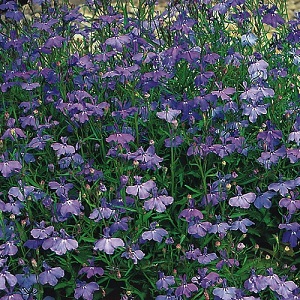
A trailing variety of Lobelia with a profusion of violet blue flowers with white eyes, flowering all summer from June/July to the first frost. These plants make attractive displays in hanging baskets and other containers and trail well over rocks and walls.
Lobelia prefers a sunny or part sunny spot and well-watered soil.
Pack of approx 1000 very small seeds. Sow in winter and spring. Sowing instructions and a colour photo are printed on the packet.
See how your seeds are packed.
| Hardiness |
Tender perennial, mostly grown as a half-hardy annual in the UK (RHS Hardiness H2) |
| Flowers |
June /July to the first frost |
| Height |
10 - 15cm |
| Spread |
25cm |
| Conditions |
Sun to part shade and composted moist well drained soils |
| Sow |
Sow in winter to spring in a clean tray of sterilised seed compost. Sow these very small seeds sparingly on the surface of the compost, and press them gently into the compost. Do not exclude light, which helps germination. Keep at 18-20 degrees Celcius (do not let the tray get too cold) and germination takes 2-3 weeks. Keep the seed tray moist as the seedlings will die if the tray dries out. Lobelia seeds can be attacked by damping off below and above the ground. Sow sparingly, use clean materials, keep the tray warm and moist, and this can generally be avoided or minimised. Sow more than you need to allow for casualties along the way. |
| Grow |
Pot on young seedlings, and plant out into the garden or into containers about 10cm apart. Harden off the plants before moving outside after the last frost (generally late May in the UK). Water and feed container grown plants regularly. Trim plants back by about 1/3rd after the first flush of flowers for more flowers up to the first frost. Remove plants once they have died down in autumn. Plants can be kept in frost-free conditions (eg a heated greenhouse) over winter and will survive several years, but most UK gardeners discard plants and grow again from seed in the spring. |
|
